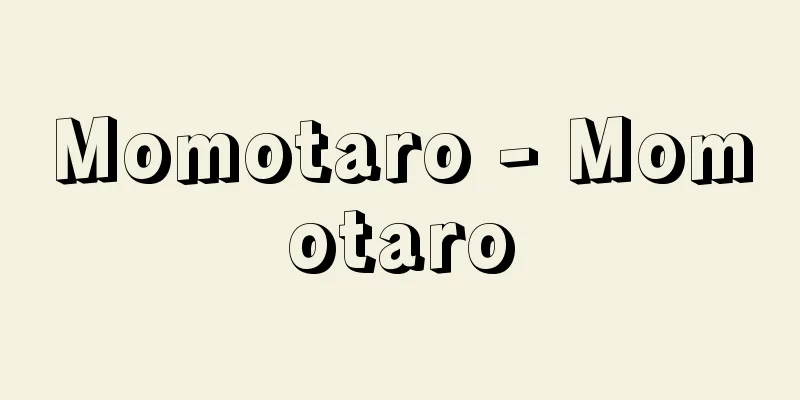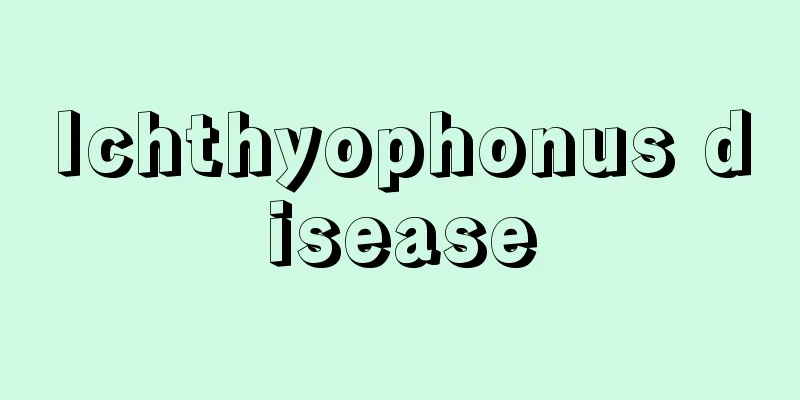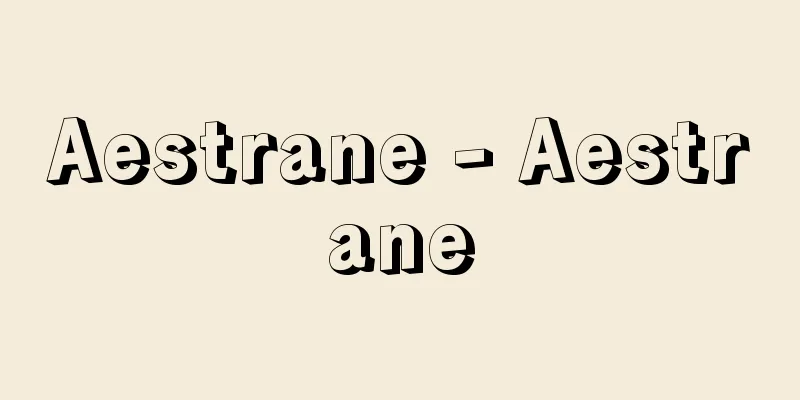Momotaro - Momotaro

|
A folk tale. One of the unusual birth stories with the theme of a hero defeating a villain. An old woman picks up a peach floating down a river. A boy is born from the peach. She names him Momotaro. When Momotaro grows up, he goes to Demon Island with some millet dumplings to defeat the demons. On the way, a dog is given some millet dumplings and becomes his servant. A monkey and a pheasant also become servants. He makes the demon surrender, gets the treasure, and returns home. It is one of the five great fairy tales from the Edo period and appears in many documents, including the Akahon "Once Upon a Time in Momotaro" from the mid-Edo period, but it is a particularly representative Japanese folk tale. Since the Meiji period, it has also become popular in picture books and reading material. When we think of "Momotaro," the most striking thing about him is that he was born from a peach, but the basic form of "Momotaro" is that of a "traveling animal" seen in "The Battle of the Monkey and the Crab." In old records such as the Akahon, the story is about an old woman who rejuvenates herself by eating a peach and gives birth to a baby. There seems to have been some significance to the abnormal birth. Momotaro may not have originally been born from a peach. Burma (Myanmar) also has a folk tale very similar to "Momotaro," with the main character being "Thumb Boy." He was born the size of a thumb because his mother cursed the sun. At the age of 16, he is given a big piece of cake to fight the sun, and sets off. Everyone is suffering from the midsummer sun. On the way, he meets a boat on a dried-up river. The boat is given a piece of cake and eats it, becoming his companion. A bamboo thorn, moss, and a rotten egg also join him in the same way. He enters the house of a man-eating ogre to wait for the sunrise. The ogre returns. When he goes to sleep, the bamboo thorn under his bed hurts him. When he approaches the fire to turn on the light, the egg bursts and ash gets into his eyes. When he goes to wash his eyes, he slips on the moss, falls, breaks his neck, and dies. The next morning, the boy and his companions challenge the sun. The rain supports the boy, bringing heavy rain and flooding, but the boys return on their companions' boat. It is a story about the end of the dry season, when everyone is suffering, and the beginning of the rainy season, which brings about abundant harvests. The characteristics of "traveling animals" are well displayed in this story, but the idea of animals sharing food and becoming friends is the same as in "Momotaro". An important feature is that the enemy in the battle is the sun (probably in the form of a man-eating ogre), the master of natural phenomena. The "Battle with the South Wind" in the myth of the semi-divine Raven of the Northwest Coast Indians of North America is an example of a "traveling animal" in which the Raven invites his friends, including fish who are suffering from starvation due to the strong south wind, to the house of the owner of the south wind and punishes them to stop the strong wind. This is also a story about defeating the owner of a meteorological phenomenon and achieving a prosperous life, and the fact that "Momotaro" and the Burmese "Thumb Boy" share food probably indicates that it is a famine. The demon in "Momotaro" is said to have tormented people, but it may have actually been the owner of the meteorological phenomenon that brought about famine. The well-known origin of "Momotaro", where an old man goes to the mountains to cut brushwood and an old woman goes to the river to do laundry, was originally a form of opening the story of Japanese old tales, one of the "storytelling styles", and is used in old tales other than "Momotaro", such as "Urikohime". There are Chinese folk tales about heroes born from peaches, but they are not of the "Momotaro" or "Traveling Animals" type. In China, peaches are considered to be an elixir of eternal youth and a curse that drives away demons, and this belief has also spread to Japan. It is likely that this was established in this folk tale as a component of the protagonist's unusual birth. The reason why "Momotaro" was a representative Japanese folk tale is probably because the basic structure of this folk tale, in which a godly protagonist fights against the master who is causing the abnormal weather and lives a peaceful life in the future, seemed to be the mainstream of the world of folk tales in Japan. The same reason is probably why the "narrative style" was firmly linked to "Momotaro." It is also significant that Kunio Yanagita and Eiichiro Ishida saw the belief in a small child god behind "Momotaro" as a cultural foundation that supports folk tales. There is also a story in "Momotaro Emaki" (1735) in which Momotaro rescues a princess and marries her, but this is not considered to be the original form. [Yo Kojima] "The Birth of Momotaro, by Kunio Yanagita (Kadokawa Bunko)" ▽ "The Transformation of the Image of Momotaro, by Michio Namekawa (1981, Tokyo Shoseki)" ▽ "The Fate of Momotaro, by Makoto Torikoshi (1983, Japan Broadcasting Publishing Association)" Source: Shogakukan Encyclopedia Nipponica About Encyclopedia Nipponica Information | Legend |
|
昔話。英雄が悪者を退治することを主題にした異常誕生譚(たん)の一つ。婆(ばば)が川を流れてくる桃の実を拾う。桃から男子が生まれる。桃太郎と名をつける。桃太郎が一人前になると、鬼が島へ黍団子(きびだんご)を持って鬼征伐に行く。途中、犬が黍団子をもらって家来になる。猿、雉子(きじ)も同様に家来になる。鬼を降参させ、宝物をもらって帰る。 江戸中期の赤本『むかしむかしの桃太郎』をはじめ、多くの文献にみえている江戸時代の五大童話の一つであるが、とくに日本を代表する昔話になっている。明治以後は、絵本や読み物でも親しまれている。「桃太郎」というと、桃から生まれたということが印象的だが、「桃太郎」の基本形式は「猿蟹(さるかに)合戦」にみえる「旅する動物」である。赤本など古い記録では、婆が桃を食べて若返り、赤子を生む話になっている。異常誕生に意味があったらしい。桃太郎も本来は桃から生まれたものではなかったかもしれない。 ビルマ(ミャンマー)にも「桃太郎」とよく似た昔話があり、主人公は「親指小僧」になっている。母が太陽を呪(のろ)ったために、親指大に生まれる。16歳のときに、太陽と戦うために大きな菓子を一つつくってもらって出かける。真夏の太陽で、みんな苦しんでいる。途中、干上がった川の船に会う。船は菓子ひとかけらをもらって食べて仲間になる。以下、竹いばら、苔(こけ)、腐った卵が同様にして仲間になる。日の出を待つのに人食い鬼の家に入る。鬼が帰ってくる。寝ると寝台の下にいた竹いばらが傷つける。明かりをつけようと火に近づくと、卵が破裂して目に灰が入る。目を洗いに行くとき、苔ですべって転び、首を折って死ぬ。翌朝、小僧は仲間とともに太陽に挑戦する。雨が小僧を支援して大雨を降らせ、洪水になるが、小僧たちは仲間の船に乗って帰る。みんなが苦しんでいる乾期から、豊かな実りをもたらす雨期を迎える物語である。これにも「旅する動物」の特徴がよく現れているが、食物を分けてもらって仲間になる趣向は「桃太郎」と同一である。戦いの相手が、自然現象の主である太陽(おそらくは人食い鬼の姿)であるのは重要な特色である。 北アメリカ北西岸インディアンの半神的なワタリオオガラスの神話にある「南風との戦い」は、ワタリオオガラスが、激しい南風が吹いて飢餓状態で困っている魚類などの仲間を誘って、南風の主の家に行き、懲らしめて烈風を止めさせる、「旅する動物」の一例である。これも気象現象の主を退治して豊かな暮らしを実現する話で、「桃太郎」やビルマの「親指小僧」が食物を分け与えているのも、飢饉(ききん)であることを示すものであろう。「桃太郎」の鬼も、人々を苦しめた鬼といわれているが、本来は飢餓をもたらす気象現象の主であったかもしれない。「桃太郎」の発端としてよく知られている、爺(じじ)は山へ柴(しば)刈りに、婆は川へ洗濯にという趣向は、もともと日本の昔話の語り始めの型、「語りの様式」の一つで、「瓜子(うりこ)姫」など、「桃太郎」以外の昔話にも用いられている。 桃から生まれた英雄の昔話は中国にあるが、「桃太郎」や「旅する動物」の型ではない。桃は中国では不老長寿の薬、鬼を払う呪物(じゅぶつ)とされ、その信仰は日本にも入っている。主人公の異常な誕生の構成要素として、この昔話に定着したものであろう。「桃太郎」が日本の昔話の代表格であったのは、神的な主人公が異常な天候を起こしている主と戦い、平穏な暮らしを将来するという、この昔話の基本構造が、日本では、昔話世界の本流のように思われるところがあったのであろう。「語りの様式」が「桃太郎」と固定的に結び付いていたのも、同じ理由であろう。柳田国男(やなぎたくにお)や石田英一郎が「桃太郎」の背後に小さ子神信仰があるとみたのも、昔話を支える文化的基盤として意味のあることである。『桃太郎絵巻』(1735)のように桃太郎が姫を助け出して結婚する話もあるが、本来の形とは考えられない。 [小島瓔] 『柳田国男著『桃太郎の誕生』(角川文庫)』▽『滑川道夫著『桃太郎像の変容』(1981・東京書籍)』▽『鳥越信著『桃太郎の運命』(1983・日本放送出版協会)』 出典 小学館 日本大百科全書(ニッポニカ)日本大百科全書(ニッポニカ)について 情報 | 凡例 |
<<: Volcán Momotombo (Mountain) (English spelling)
Recommend
Crow invitation - Karasukanjo
...Atsuta Shrine in Nagoya, Taga Taisha in Omi, a...
Eastern pale clouded yellow
A butterfly belonging to the family Pieridae in t...
Nguyen Kim
… After the death of Thanh Thong, the imperial po...
Image
[Noun] A brick with an image on it. Since the Han ...
Erinna - Erinna (English spelling)
Date of birth and death unknown. A Greek female p...
Mackerel
A small, light, flat-bottomed boat unique to the R...
Izu Province Islands Products Exchange - Izu no Kuni Tsukishimajima Sanbutsukaisho
…In 1794 (Kansei 6), the shogunate also took issu...
al-Tha`ālibī, Abū Manṣūr `Abd al-Malik
[Born] 961. Nishapur [Died] 1038. Nishapur, a man ...
selenium
Se. Atomic number 34. Electron configuration [Ar]...
Sagunto (English spelling)
A city in the northern part of Valencia Province, ...
Yaesu
A district in Chuo Ward, Tokyo, east of Tokyo Sta...
mawlā (English spelling) mawla
…the plural form of the Arabic word mawlā. In the...
Electrocoagulation
...It consists of a high-frequency current genera...
Living shrine - Seishi
A living person is worshiped as a god and a shrin...
Catalyst - Catalyst
A small amount of a substance accelerates the rat...









